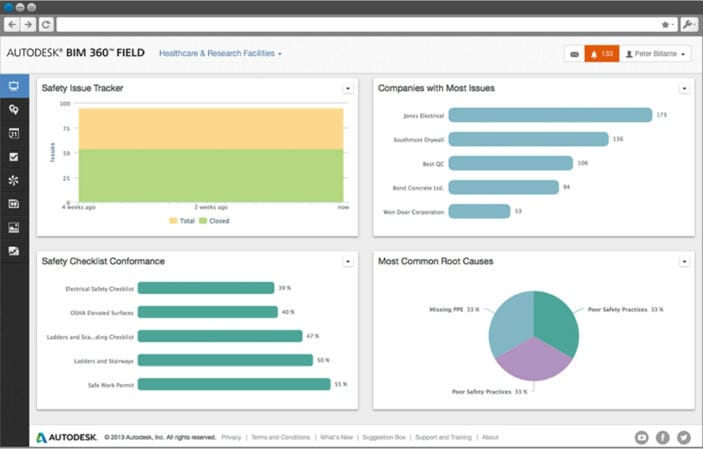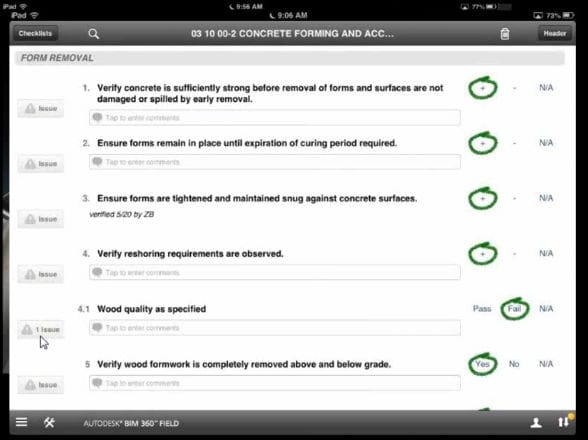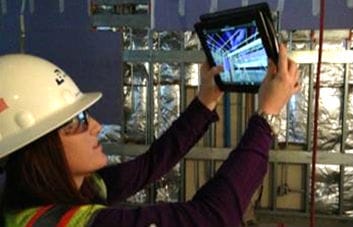Interview with Andrew Bowles from AUTODESK’s BIM360

Tablets, apps and lately wearables are here to stay and to change our lives forever. With slow but steady steps, construction industry will probably become one of the most fascinating applications of these new technologies.
I recently had the opportunity to discuss with Andrew Bowles , Territory Manager (EMEA) of Autodesk’s BIM360 about their solution and about the new technologies that are coming out.
Autodesk BIM360 is the former Vela Systems. What exactly is BIM360 and what’s the story behind it?
Actually BIM 360 is more than the former Vela Systems solution that was acquired by Autodesk in 2012. It is a platform of services that currently includes BIM 360 Field (formerly the Vela Systems solution referenced above) and BIM 360 Glue. As a cloud based solution with connected iOS Apps for the iPad, BIM 360 allows anytime, anywhere access to project data to collaborate, visualize, and improve quality and safety. The power of the platform lies with the fact that the connected services enable contractors to visualize and collaborate with the project models as well as conduct work at the point of work, not in the site office.
How many Projects (in a global scale) have used BIM360 and how exactly did it help them?
We are not able to comment on the number of projects under management, but we can say that BIM 360 is seeing incredible traction in the market – in fact, it’s the fastest growing product in Autodesk’s 30+ year history.
Speaking about Quality Management, how could BIM360 help a Quality Manager or a Quality Engineer and Inspector on site (and back in the office of course)?
BIM 360 Field is a solution that automates the process of creating quality routines while helping to build a process that connects the project stakeholders together for real-time data sharing. Quality managers can easily create lists and checklists, shared across the project for documenting issues and viewing progress updates. Because the data is shared in real-time across the project, he or she has access to reports that help to proactively identify trends early that can help reduce jobsite risks.
In the field, construction quality can be tracked using standardized checklist templates that are easy to use and configure. Teams can use push pins to easily pinpoint issues on 2D plans or 3D models and use photos to document and mark-up issues. Back in the office, BIM 360 Field can drive programs for improving quality with cross-project reports to immediately see current status on issues and identify trends. Furthermore, QA/QC checklists can be pre-assigned to model components, meaning quality management isn’t something that is just done, it is something that can be planned for in advance to reduce profit eating rework downstream.
Incidentally, I recall one of your previous blog posts in November 2013 where you wrote “If the data coming from the field through the tablets, could easily be integrated or combined with a BIM solution that would implement a “quality vocabulary” (attaching NCRs, ITPs, Audits and observations) it would probably provide the perfect solution for any Quality Professional in the industry”. I’m pleased to report that is exactly how many BIM360 clients are using the solution today.
There are many online collaboration tools, snagging apps and Document Management software for construction industry out in the market at the moment. We are probably in the middle of a digital revolution in construction industry which is pretty exciting. So, what makes BIM360 different?
I completely agree, it’s a very exciting time. At Autodesk we are seeing the confluence of three industry trends; increased demand for the use of mobile devices to drive productivity and increase efficiency in the Field, increased uptake of cloud computing, and of course increased BIM adoption. These factors combined are creating the perfect storm for BIM360, as contractors look to rationalise the number of IT systems they use and identify more seamless ways of joining site based operations with the reporting needs of senior management teams back in the office. I firmly believe (as with what we saw with the project extranet market over the past decade) that in the not too distant future, it will be highly unlikely not to see the use of mobile field management applications on all mainstream projects.
BIM360’s key differentiator in the market is that it is far more than just a ‘point solution’ for 2D snagging and quality management. BIM360 provides access to documents and drawings in the field reducing reproduction costs and time spent walking to and from the site office. Bar code scanning for the tracking of key building components and commissioning of MEP helps to de-risk projects and accelerate project schedules. Furthermore, the tool is ‘future- proof’ in the support of BIM, as site based workers can access 3D models in the Field and pass attribute data back to the model (through industry leading tools like Revit, Navisworks and BIM360 Glue), supporting a more seamless client handover process. This is a use case scenario that is gaining significant momentum at the moment, as contractors look to innovative ways of delivering data-rich and accurate Asset Information Models to satisfy Employers Information Requirements.
Interestingly, contractors I speak to on a regular basis tell me that owner/operators are now beginning to be more prescriptive around their handover requirements during the tender process. The ability to articulate the use of data capture tools such as BIM360 means they are looked on more favourably than if they were to respond with just traditional paper-based O&M compilation methods. I would suggest that this point of differentiation during the work-winning process should not be underestimated when considering an investment in the BIM360 platform. At its heart, BIM 360 is an enterprise-level, project, and team collaboration platform that breaks-down the data exchange barriers between construction project stakeholders. The BIM 360 architecture allows for organizations to create best practices—contained with the system, to extend similar efficiencies to all of their projects. Additionally, the BIM 360 platform extends beyond just apps for the iPad. While the iOS apps themselves are powerful, the browser-based cloud services for BIM 360 Field and BIM 360 Glue allow for a common-shared database. This makes the exchange of data between the services seamless and efficient. In summary, these capabilities ensure we can support our clients, no matter where they are on the BIM maturity curve.
BIM is by far the hottest topic in construction industry the last years. Obviously, Autodesk with Revit already has that tool in place. However, how is BIM360 collaborating with BIM Software (like Revit or else)? Is BIM necessary to use BIM360? What if the project I am working is not using BIM technology?
BIM is certainly a topic that has garnered a great deal of attention over the last 6-7 years, not least because of Governmental/Owner mandates. We believe that while the model aspects of BIM are important, the “I” in BIM lies closer to BIM 360’s promise for contractors. Many contractors, even if not yet adept at virtual design and construction principles, are still able to utilize and collaborate with project stakeholders using BIM 360—-as a means to share field level data more efficiently than they have in the past. In short, BIM is not a prerequisite to using BIM360. That said, the contractors using both Autodesk Navisworks and BIM 360 Glue can effectively “push” and “pull” models between the two products. For example, you can publish coordinated models from Navisworks Manage to BIM 360 Glue and conversely, users can load coordinated BIM 360 Glue models into Navisworks for advanced analysis like model-based quantification or 4D simulation.
All snagging and completion of the checklists are performed through the BIM360 iOS App. Is there any Android app? Are there any plans of building an Android app?
There are no plans as of yet for Android. At this time, we are committed to aligning our development resources on delivering a singular mobile platform supporting the project lifecycle. This allows our team to focus and deliver the highest calibre solution possible.

If there are items (e.g. NCRs, RFIs) that need to be communicated to people that are not using BIM360 and they may not even belong to my organization (Clients, Designers, Authorities), is it possible to do so? How exactly?
BIM 360 has an open platform and API’s (Application Programming Interface). You can connect BIM 360 projects to your enterprise applications and business processes. For example, you can view BIM 360 project models from directly within SharePoint, and you can integrate with project management systems to create RFIs linked directly to BIM.
What kind of statistics, KPIs or dashboards can be produced with BIM360? Are they automatically produced or people still have to export to spread sheets?
Inherent within the BIM 360 Platform of services is the ability to monitor interactions and actions conducted within BIM 360 Glue and BIM 360 Field. For example, within BIM 360 Glue, administrators can monitor collaborative activities and model iterations across projects, for improved insight into project status. Additionally, cross-project activities can be viewed by weekly, monthly or total activities. Within BIM 360 Field, administrators can view cross project trends in field performance of teams and trades in quality, safety and other areas. So, no ugly spreadsheet exports needed!

It seems that the last years the use of tablets on site is booming, with new apps and tools coming out almost every month! When do you think construction industry will move completely to a “tablet-driven digital environment”? Is that even possible?
The lines between “desktop” and “mobile” are becoming more blurred day by day. With Autodesk pushing a great deal of computer intensive processes for our applications to the cloud, the limitations of computing power are removed from user concern. Once computing power (hardware) is removed from the equation, format and screen size become the limiting factor. So, yes the hefty CPU computers we use in the “back-office” today could be replaced by large format tablets, with the field personnel using smartphones and smaller format tablets (as we are seeing today).
What are the future plans for BIM360? Are there any new features coming out soon?
As a public company we cannot provide specific details as to feature enhancements with future releases. But it is safe to say that BIM 360 is Autodesk’s flagship solution for vertical construction and therefore will continually receive feature enhancements and new capabilities that will allow general contractors and subcontractors to manage their projects more efficiently.
For more information about BIM360 , you can visit : https://www.autodesk.com/bim-360/
Many thanks!
PS: QualityInConstruction.com is not commercially linked with any of the products that are presented or any of the interviewees.
Member discussion